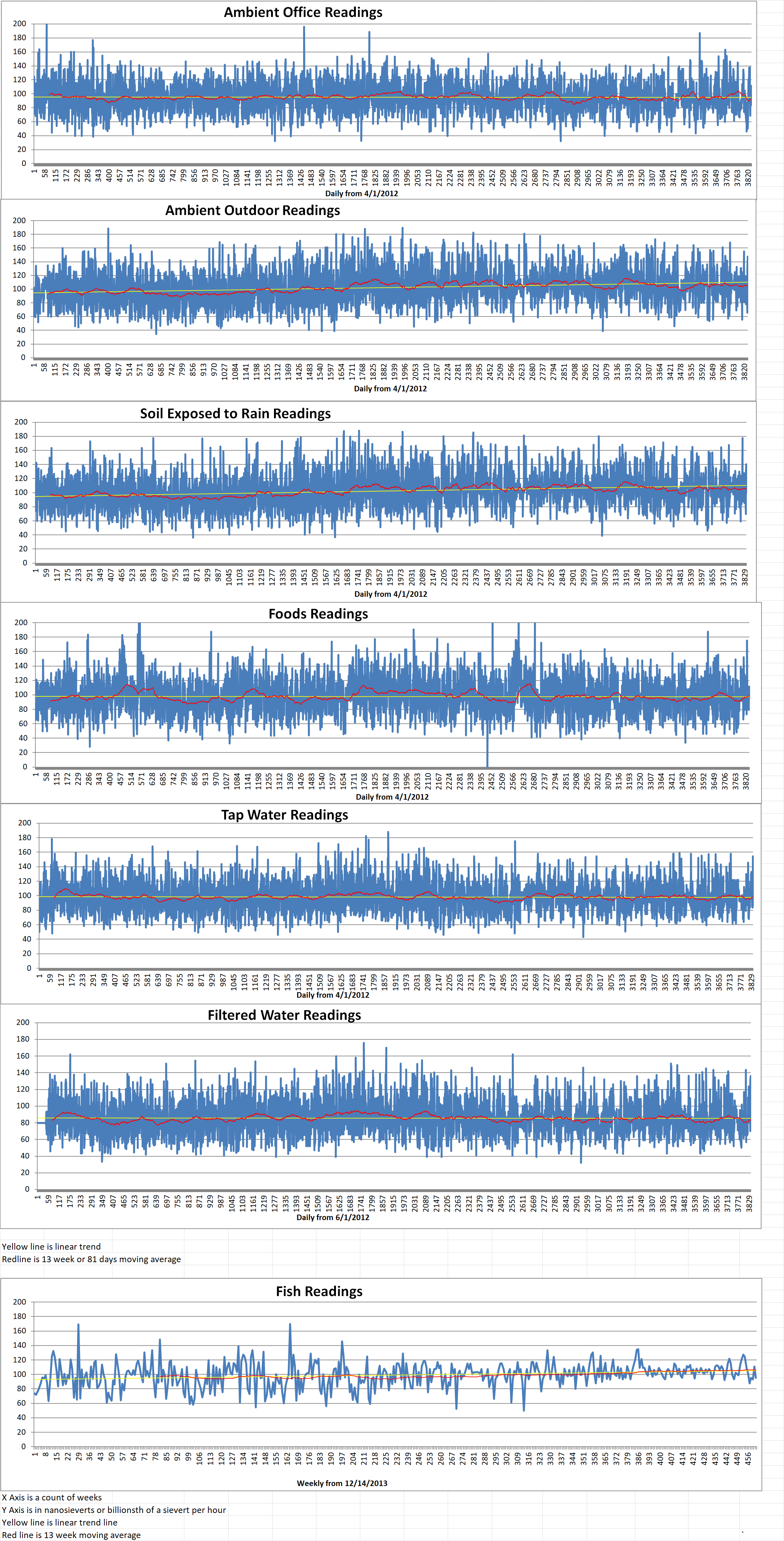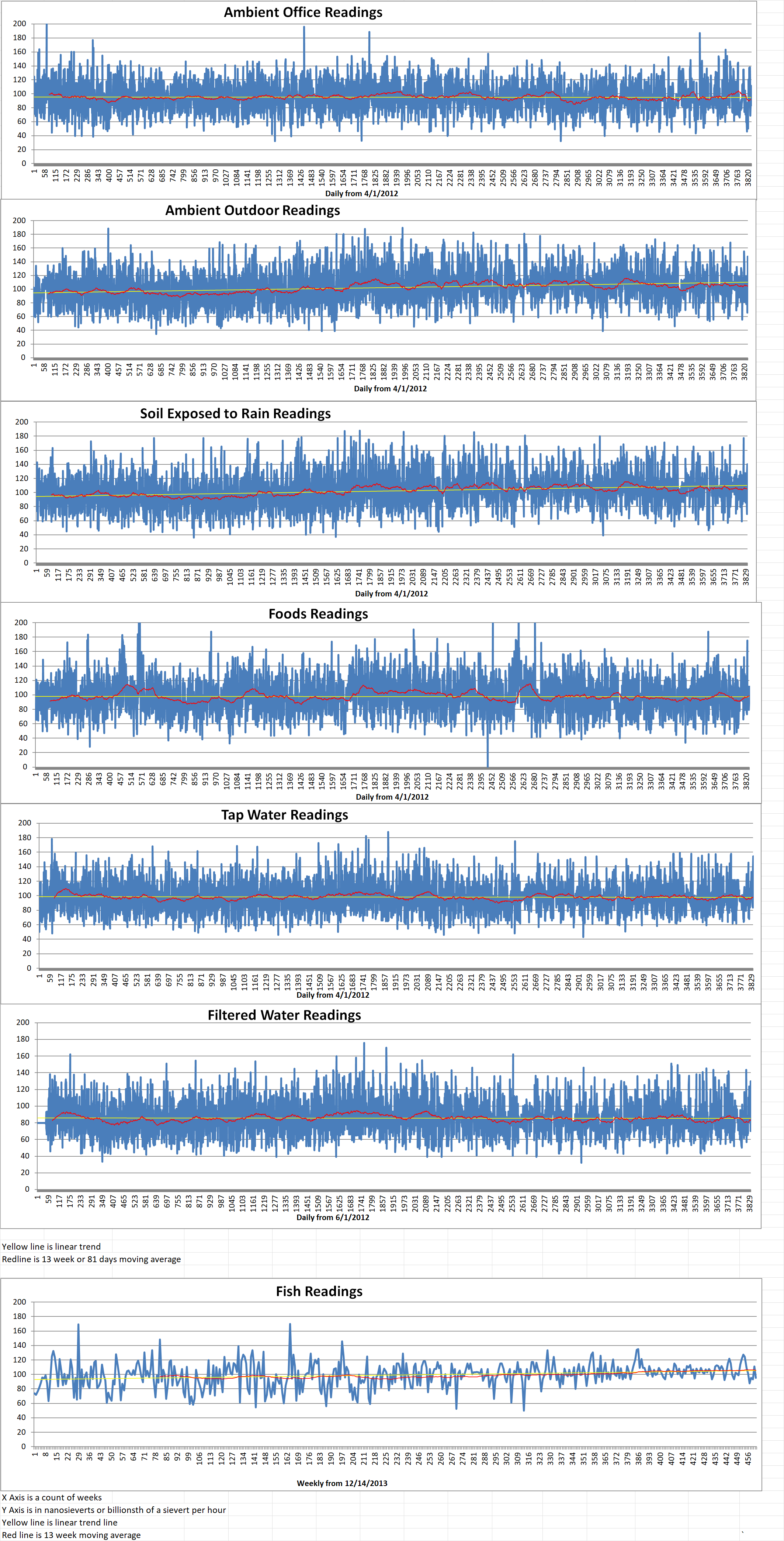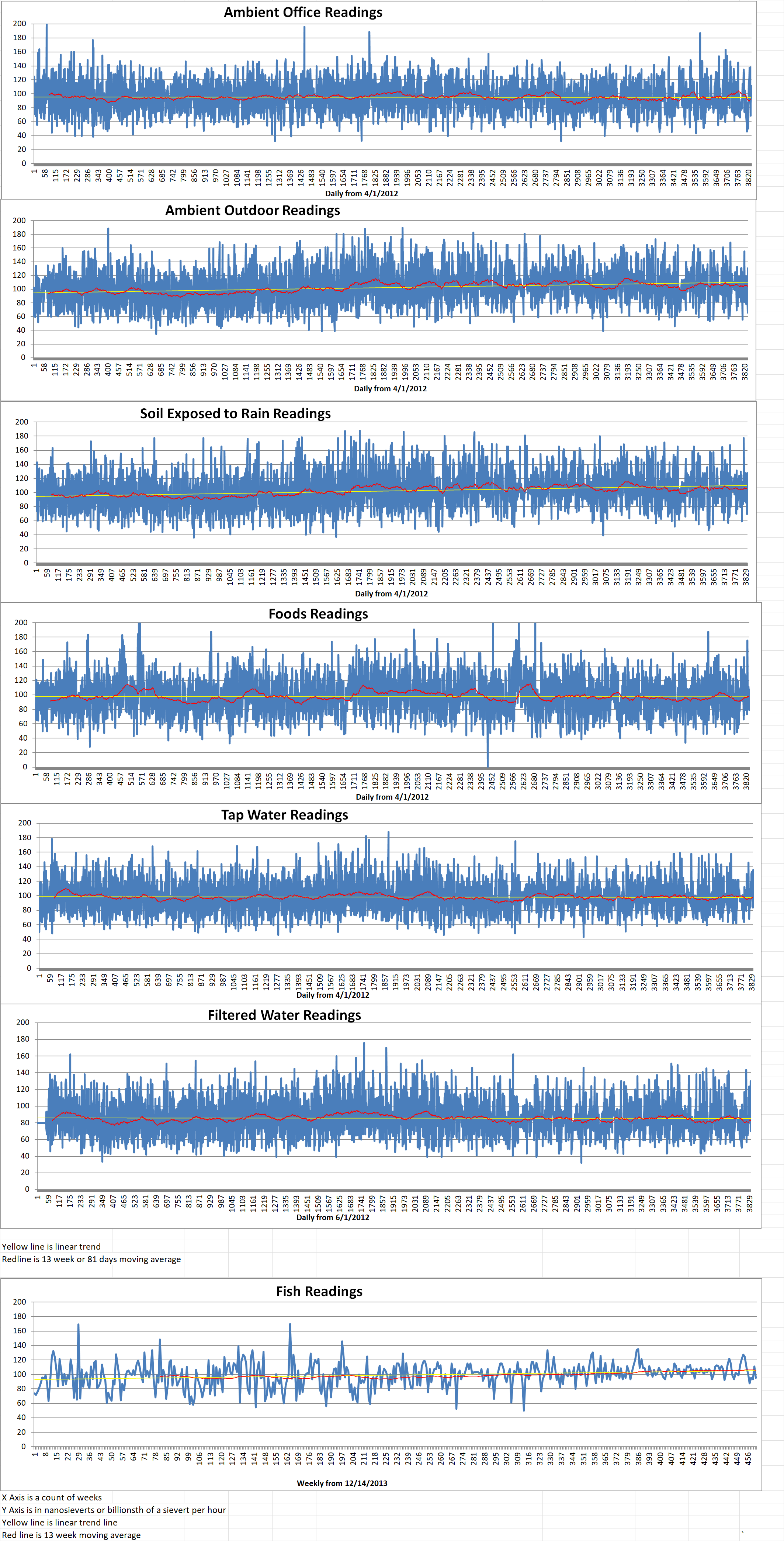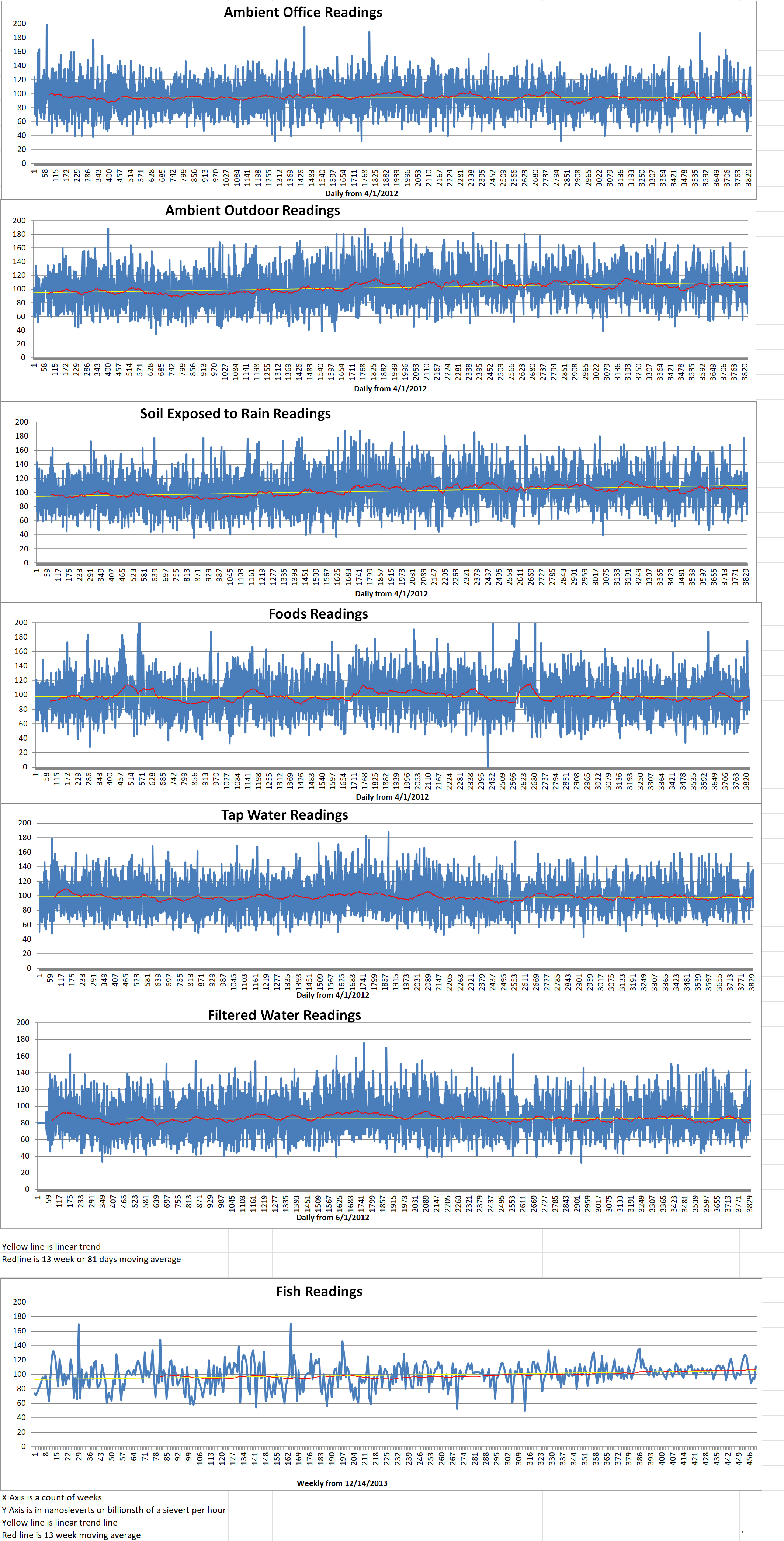Blog
-

Geiger Readings for Jan 02, 2022
Ambient office = 111 nanosieverts per hour
Ambient outside = 95 nanosieverts per hour
Soil exposed to rain water = 100 nanosieverts per hour
Grape from Central Market = 106 nanosieverts per hour
Tap water = 87 nanosieverts per hour
Filter water = 81 nanosieverts per hour
-
Nuclear News Roundup Jan 01, 2022
Why Did Portland General Electric Want to Build Trojan Nuclear Plant in the First Place? Wweek.com
German minister reignites coalition row with call to review nuclear exit finance.yahoo.com
US nuclear enjoys revival as public and private funding pours in ft.com
US Not Discussing Nuclear Exercises With South Korea, Biden Says voanews.com
-

Geiger Readings for Jan 01, 2022
Ambient office = 83 nanosieverts per hour
Ambient outside = 148 nanosieverts per hour
Soil exposed to rain water = 140 nanosieverts per hour
Blueberry from Central Market = 111 nanosieverts per hour
Tap water = 155 nanosieverts per hour
Filter water = 136 nanosieverts per hour
-
Nuclear News Roundup Dec 31, 2022
Patient Coalition Applauds Federal Decision Impacting Nuclear Medicine Safety itnonline.com
Philippines updating nuclear energy roadmap gmanetwork.com
Nuclear stations near New Castle County to conduct quarterly sirens test Tuesday baytobaynews.com
Will Big Plans For Nuclear Power Work Without Russian Uranium? Finance.yahoo.com
-

Geiger Readings for Dec 31, 2022
Ambient office = 95 nanosieverts per hour
Ambient outside = 130 nanosieverts per hour
Soil exposed to rain water = 128 nanosieverts per hour
Avocado from Central Market = 100 nanosieverts per hour
Tap water = 135 nanosieverts per hour
Filter water = 130 nanosieverts per hour
Dover Sole from Central = 95 nanosieverts per hour
-

Nuclear Reactors 1116 – Can Small Modular Reactors Or Microreactors Be Used To Power Data Centers – Part 2 of 2 Parts
Part 2 of 2 Parts (Please read Part 1 first)
Despite the success of U.S. Navy nuclear reactors, many people still remember meltdowns at Three Mile Island, Chernobyl and Fukushima. These nuclear disasters have resulted in the stigmatization of nuclear power as a dangerous and unnecessary risk.
The Omdia report argues that the recent developments around SMRs have resolved many of the design and safety challenges association with older reactor designs. The report stated that “SMRs are considerably smaller than the large power plant reactors most of us are familiar with. Thus, SMRs pose far less risk due to their scale, simple design, and inherent safety characteristics of the reactor. The biggest challenge is going to be convincing people in industry and the people where these things are going to be deployed, that it is safe, and viable, and environmentally friendly.”
While it may turn out that SMRs will have a better track record than large, pressurized water reactors, there is still the major problem of nuclear waste. Although nuclear energy may be cleaner than coal or natural gas, it is not renewable. Nuclear power reactors produce heat generated by the controlled fission of elements such as uranium, plutonium, or thorium. The byproducts of the nuclear reactions produce radioactive waste that can take thousands of years to decay to safe levels.
The good news is that, depending on how the SMRs are built, they may not need to be refueled very often. According to Omdia, the reactors being used in nuclear submarines only require refueling about every ten years and newer designs could extend that to thirty or even forty years.
The bad news is that research suggests that SMRs are not nearly as clean as the big nuclear power reactors currently in use. A study published last summer found that SMRs can produce up to thirty-five times more waste when compared to the large reactors currently in use.
Before SMRs can gain mainstream adoption among data center operators, they must be economically viable. SMRs may be powerful enough to run a data center. However, unless they can do so cheaper than using renewables and fossil fuels, it is going to be a tough sell.
Commercial SMRs are still in their infancy. It is hard to estimate how much they might cost to operationalize. SMR startups such as NuScale claim that their reactors will have a levelized cost estimate (LCOE) of between forty dollars per megawatt hour and sixty-five dollars per megawatt hour, when they reach commercial availability during the late 2020s.
LCOE refers to the estimated revenue required to build, fuel, and operate a generator over its lifetime. On the optimistic side, this would put NuScale’s reactors close to the LCOE of natural gas and onshore wind power of about thirty-seven dollars per megawatt hour. Solar does better at about thirty-three dollars per megawatt hour.
With respect to SMR vendors, this comparison is only going to improve with time. Over the next two decades, The Energy Information Administration (EIA) expects the LCOE for wind and natural gas to steadily increase while solar power is expected to hold steady.
Nuclear power does have on major advantage over solar or wind. Renewable energy is not available in every market. Where it is, its efficiency depends heavily on nature’s cooperation. If the sun is not shining or the wind is not blowing, no power is being generate.
SMRs have faced major regulatory hurdles in the past. However, while the U.S. has been slower that other nations, the Nuclear Regulatory Commission recently cleared the way for SMRs inside the U.S.
Despite this progress, it will be some time before commercial SMRS are on the market. The Omdia report said, “The most optimistic deployment of an SMR here in the United States is by 2030. The notion of it being used on a datacenter campus, that’s going to be – and I’m only speculating here –between 10 and 15 years away.”
The U.S. is not the only country actively exploring SMR tech. According to the Omdia report, there are already several SMRs under construction or being licensed in Argentina, Canada, France and South Korea. However, just like the U.S., many of these reactors are still more than a decade away from deployment. -
Nuclear News Roundup Dec 30, 2022
IAEA to base staff at all Ukraine’s nuclear power plants world-nuclear-news.org
Yonhap: North Korea may have up to 60 nuclear warheads news.am
Chilling AI predicts what nuclear war would look like with attacks on London, Moscow and Washington the-sun.com
Defense Intelligence Constantly Monitoring Movement Of Russia’s Nuclear Weapons uknews.com
-

Geiger Readings for Dec 30, 2022
Ambient office = 111 nanosieverts per hour
Ambient outside = 66 nanosieverts per hour
Soil exposed to rain water = 70 nanosieverts per hour
Tomato from Central Market = 93 nanosieverts per hour
Tap water = 84 nanosieverts per hour
Filter water = 70 nanosieverts per hour
-

Nuclear Reactors 1115 – Can Small Modular Reactors Or Microreactors Be Used To Power Data Centers – Part 1 of 2 Parts
Part 1 of 2 Parts
Data centers consume a lot of electricity. Unfortunately, a big part of that is generated by burning fossil fuels. It would be better if a data center could generate its own power rather than depend on local utilities. It might be possible for small modular reactors (SMRs) to generate the power needed in data centers.
Alan Howard and Vladimir Galabov are analysts for Omdia. In a recent report, they made a case for using SMRs to power large data centers. SMRs are just miniaturized nuclear fission reactors. Instead of a massive facility producing gigawatts or more of power. SMRs are designed to individually generate power in the hundreds of megawatt range. The International Atomic Energy Agency (IAEA) says that SMRs can produce from twenty to three hundred megawatts of power, depending on the specific design.
SMRs are not a new concept. They have been powering U.S. Navy vessels for almost seventy years without major problems. The first nuclear powered naval vessel was the U.S.S. Nautilus in 1955. Since then, nuclear power has been a mainstay of U.S. Navy propulsion. Today, the U.S. operates a fleet of eighty-three nuclear-powered ships.
It has only been more recently that nuclear startups have begun developing and deploying SMRs in a commercial setting. Two Russian-built SMRs capable of generating thirty-five megawatts each are being utilized on a floating power plant off the Arctic coast of Russia.
With respect to the question of how many SMRs it will take to free a data center from the grid, the answer will depend on several factors.
The hyperscalars and cloud providers are reluctant to discuss how much power their data centers consume. The megawatt ratings often cited by colocation providers really reflects the upper limits of the facility’s sellable capacity. It does not match the actual power draw or the significant fraction of power required to cool them.
For example, consider a data center campus consuming about one hundred and twenty-five megawatts to cover computation, thermal management and ancillary systems. Assuming that each SMR produces thirty-five megawatts, four such reactors should supply the needed energy.
SMRs are definitely able to power a data center. Analysts say that the typical two hundred thousand square foot facility probably is not a good candidate for an onsite nuclear power plant. Instead, analysts suggest that SMRs would be more appropriate for large data center campuses. This would be especially true for those located in power-limited regions like Virginia or Ireland.
According to the Omdia report, the sweet spot for SMRs will probably be for facilities exceeding one hundred megawatts. Smaller data center could also partner with locate utilities to form co-ops in which other high power demand industrial plants could purchase excess capacity.
Microreactors are very small nuclear reactors that produce from one to twenty megawatts. They may be a viable option for smaller data centers or as an alternative to battery or diesel generators commonly used as backup power in the event of an outage.
Please read Part 2 next
